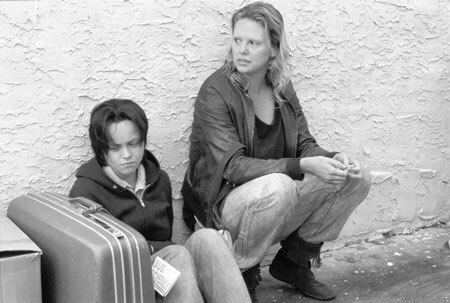Two new films, documentary and feature, tell serial killer’s story
Christina Ricci and Charlize Theron; Aileen Wuornos in custody, 1991.
She had been ratted out by her female lover of four years, Tyria J. Moore, during her first police interrogation after being arrested.
Wuornos became neither a poster girl for the lesbian movement nor a feminist icon. She had no rhetoric to defend herself other than repeating over and over, “I killed in self-defense.”
Leading feminists were split. Writer Susan Brownmiller, a founding member of the women’s movement’s second wave, warned feminists not to be blind sighted by this murderer. But, psychology professor Phyllis Chesler took up her case as a woman who let rage build up during years of sexual and physical abuse from all the men in her life until it exploded when she found what she called love with a woman.
The tabloids rags and TV shows loved her and splashed their pages and screens with images of a wild eyed, bottle-blond with raging madness in her eyes—she was America’s man-hating lesbian prostitute.
In 1992, Nick Broomfield attempted to take an honest look at Aileen Wuornos, but soon after starting his film realized he had stepped into a sinkhole of cynical opportunism this woman’s notoriety had attracted from the strange lot of folks with whom she chose to surround herself. In “Aileen Wuornos: The Selling of a Serial Killer,” Broomfield focused on two: Arlene Pralle, a 44-year-old born-again horse raiser, and her husband who legally adopted Wuornos because “God told her to.” Pralle pleaded with her to “get straight with the Lord and ‘fess up so the Lord would set her free.” But she also became Wuornos’ agent, began negotiating fees for interviews, and helped her get her first attorney, a hippie throwback named Steve Glazer who advertised on late night local TV as a “singing” lawyer. Broomfield also found that even the arresting cops joined forces with Moore to sell the story.
Aileen Wuornos’ trial for the murder of the six men revolved particularly around a convicted sex offender, Richard Mallory, who had spent ten years in jail for crimes against women. Wuornos said he tortured her by using rubbing alcohol as a lubricant for anal intercourse after having burnt her vagina. She said she killed him in self-defense as he attempted to tie her up and anally rape her. Her lawyer was not aware of Mallory’s record and the jury was not informed.
Wuornos’ lover, Moore, testified that Aileen told her she had killed him. Wuornos could not contain herself in the courtroom and acted out in a manner familiar to anyone who followed the desperate anger of Francis Farmer or the self-destructive rage of Courtney Love.
Broomfield’s grotesque and passionate documentary set the foundation for asking, “Who is this woman and why is she raging?”
In 2001, after nearly a decade on death row and enduring failed appeals initiated by anti-death penalty advocates and social justice attorneys, Wuornos decide she had had it. She said she would not get justice because nobody could believe a prostitute could be physically abused and raped to the point of killing as an act of self-preservation. Against the advice of her attorney, Wuornos petitioned the court to stop all appeals and set the date for the execution, changing her story to say she killed and robbed for money. She was executed on October 9, 2002.
Finally Hollywood called. On the eve of Wuornos’ execution, Patty Jenkins, a first time, but well connected director, announced production of “Monster,” a feature film. Jenkins said she envisioned the film as a love story. Charlize Theron, the former ballet star and super model from South Africa and now a screen siren, was snagged to play the lead, also winding up as producer.
Theron has made her mark as a smart, icy cold screen beauty, about as far away physically from the ravaged Wuornos as any current Hollywood star could be. Unknown to the world when the casting coup was announced, however, was Theron’s own tragic childhood. She had watched her mother shoot her alcoholic father when she caught him sexually abusing Charlize.
Meanwhile, Broomfield was already at work on a follow-up documentary, “Aileen: The Life And Death of a Serial Killer”—perhaps in hope that he could tell the truth about the women he found to be at once both cannily smart and self-destructively out of control.
So the stage was set to have a reality-based documentary and a narrative love story, competing to explain who Aileen Wuornos was, hit theaters at the same time.
Jenkins chose to ground her script on a single key premise—Wuornos was not a lesbian. After all, she had sex with men and had married a 76-year-old man when she was 22. Only when she was met Moore, seductively played to the hilt by Christina Ricci in a performance reflecting deep insight into how a butch bottom can manipulate a hard fem top, did Wuornos meet someone she thought she could actually love. In Jenkins’s vision, keeping that love was the reason that Wuornos killed and robbed johns—she needed to keep her baby butch princess in motels and take out food.
For Jenkins’ film, Theron transformed herself with a 30-pound weight gain, and adopted the loutish swagger of an aggressive woman on the skids, responding to Ricci’s pouty aggressor saying, “I am not gay.” From that point, Jenkins proceeds to frame everything about Wuornos in the context of an unhealthy relationship that is anything but a love story.
“Monster” has it moments, particularly when Theron and Ricci interact, but this is no “Boys Don’t Cry.” It is a small film trying to tell a big and complicated story with a splashy performance, that nonetheless is not moving, and a simplistic romance aimed at explaining away the inhumanity on all fronts.
For his new documentary, Broomfield went to Troy, Michigan to discover the family Wuornos came from. Abandoned by her mother two months after she was born and brought up by her father until he was jailed for child molestation, she and her brother then went to live with her mother’s father. At nine, she was trading sex with her brother and his friends for candy. At 13, a child she had by a 60-year-old man had been removed, and she was thrown out of the house, taking refuge in the woods where she made money having sex with teenage boys.
Two years later, Wuornos headed for Florida’s warmer climate of Florida and from them on, except for the short period she was married, worked consistently as a transient hooker on the interstate highways. In her late 20s, she began having relationships with women.
Broomfield and cinematographer Joan Churchill tracked down two Michigan contemporaries of Wuornos, one who says he and his friends used her for sex and the other, a born-again ex-drag queen who speaks warmly of how he and Wuornos bonded at 13 when they both hid out in the woods.
Broomfield interviews Aileen again and she says she now wants to die, so she is copping to the crimes. But, she is also brazenly articulate about how she acted in self-defense when she did her killing. It is a chilling look at desperate madness clothed in self-aggrandizing self-destruction.
“Aileen: The Life And Death of a Serial Killer” is not only a far more authentic and, consequently, desperate insight into this tragedy, it is also a searing indictment. The family, the neighborhood, the educational system, and the social services systems all let this child and later adult slip through the cracks, invisible until she her cry for help was twisted into murder.
Aileen Wuornos grew into a feisty monster living on her wits and selling the only commodity she had to support herself. She should have been institutionalized and treated years before she grew into a dangerously damaged and murderous woman. In her last interview with Broomfield the day before her execution, Wuornos talks about wires planted in her head and the use of sonic pressure to control her thoughts, making a mockery of Gov. Jeb Bush’s claim that she had the mental competency to be put to death.
See both films if you can, if for no other reason than to see how commercial concerns stunted the dramatic quality of the narrative and allowed a misrepresentation of lesbian love to be distorted into a love story between two desperate sick women capable of nothing more than being needy. For once in our contemporary hipster culture, the prostitute is not held up as an empowered woman responding to capital exploitation, but rather in the true light of exploitation at the hymen level.
Aileen Wuornos cannot be mythologized as a feminist hero nor should she be as a man-hating lesbian. That would be far too simple an excuse for a society that at its core seems to care less and less for the children who are victims of adult narcissistic behavior and blames the victims for the monsters they become. What Broomfield accomplishes in his important documentary is a loud critique of the use of the death penalty to silence the crimes created by social problems easier to ignore than address in order to please the rabble who, overstimulated by senseless tabloid culture, seeks only bloody revenge. Aileen Wuornos emerges as a criminally insane person who should have been institutionalized, not executed.
We also publish:



































